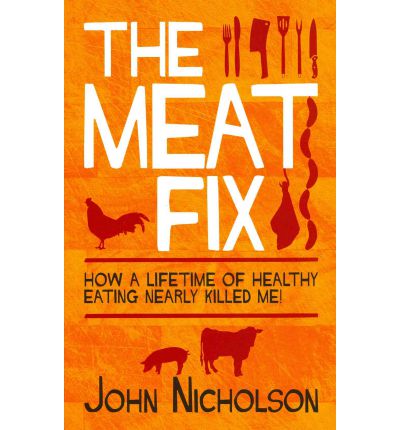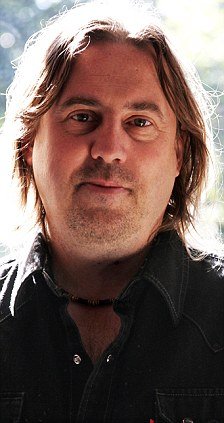
John Nicholson’s book “The Meat Fix. How a lifetime of healthy eating nearly killed me!”presents author’ story of how eating meat again, after twenty-six vegetarian years, changed his life powerfully for the better, and of his quest to understand why the supposedly healthy diet he had existed on was actually damaging him.
The reformed vegan John Nicholson has gorged on all the foods his granny enjoyed… and has never felt better.
“As the kitchen filled with the smell of caramelized meat, my mouth watered in anticipation of the coming feast: a thick cut of tender steak, fried in butter and olive oil.
This was not a regular treat. In fact, for the previous 26 years I’d been a vegan, eschewing not just meat but all animal products.
My diet was an extreme version of the NHS Eat Well regime, which recommends lots of starchy foods and smaller quantities of saturated fats, cholesterol, sugar and red meat.
According to government advice, I was doing everything right – and yet my health had never been worse. My weight had crept up over the years, until in 2008 I was 14½ stone – which is a lot of blubber for someone who is 5ft 10in – and was classified as clinically obese.
I waddled around, sweating and short of breath, battling extremely high cholesterol and suffering from chronic indigestion. I was always tired and needed to take naps every afternoon. I had constant headaches and swallowed paracetamol and sucked Rennies like they were sweets.
Worst of all, I had irritable bowel syndrome (IBS), which left me feeling as if I had lead weights in my gut. My belly was bloated and distended after every meal. I was, to use a technical term, knackered.”

“But that was about to change. In 2010, I decided to give up my supposedly healthy lifestyle and embrace good old-fashioned meat.
From that day on, I ate red meat four or five days a week. I gobbled the fat on chops, chicken skin and pork crackling. I feasted on everything we’re told to avoid. The effects were instant.
Twenty-four hours after eating meat again, all my IBS symptoms had gone. As the weeks and months passed, every aspect of my health improved dramatically. I became leaner, shedding body fat and becoming stronger and fitter. My headaches went away, never to return. Even my libido increased.
It felt like being young again, like coming back to life. But though I felt energized, I was also furious.
Furious with myself for sticking to the “healthy” eating advice, which was actually far from a sensible diet. But also furious with the so-called experts who have been peddling this low-fat, high-carbohydrate claptrap for so long that no one thinks to question it.
My maternal grandmother would certainly have challenged it. Like my grandfather, she was born into a poor family in East Yorkshire at the turn of the century and their eating regime was simple: meat and at least two vegetables at every meal, lots of butter and full-cream milk (they would have scorned yogurt as little more than “off” milk), bread, potatoes, cake and puddings.
Nothing would have swayed them from that lifestyle. Had a low-fat diet been suggested by a doctor, Gran would have told him to his face that it was all rubbish and that you needed fat to “keep the cold out”.
If she could have seen people buying skimmed milk today, she would have thought they had lost their minds. Getting rid of the best bit of milk? Lunacy.
Late in her life, I recall her scorning the advice on limiting the consumption of eggs because of concerns about cholesterol. On one occasion, she watched in astonishment as a celebrity TV chef made an egg-white omelette. “He’s a bloody fool, that man,” she said.
She was right to be skeptical, it turns out. For years the authorities told us cholesterol-rich foods would kill us – but we’ve since learned that is utter drivel.”

“While Ancel Keys, the scientist whose research in the Fifties first raised concerns about cholesterol levels, suggested that heart disease was linked to large amounts of cholesterol in the blood, he never claimed those levels were linked to the amount of cholesterol we eat.
“There’s no connection whatsoever between cholesterol in food and cholesterol in blood,” he said in a magazine article in 1997. “And we’ve known that all along.”
Since then, the NHS’s paranoia about cholesterol in food has been replaced by concerns about saturated fat – found in everything from butter, cheese and cream to pies, cakes and biscuits.
They suggest saturated fat increases the risk of heart disease. But this is open to debate.
France has the lowest rate of death from coronary heart disease in Europe, yet the country has the highest consumption of saturated fats.
Gran survived into her 80’s and Grandad into his 70’s, despite laboring down the pit his whole working life. Did they achieve this by gobbling low-fat spreads, soya oil or skimmed milk? No, they lived on old-fashioned foods such as butter, lard and beef fat. Indeed, a growing body of opinion suggests that the factory-made products that have replaced these staples – vegetable oils, polyunsaturated margarine and spreads – are the real cause of the degenerative diseases that are so common today.”

“Findings by the Weston A. Price Foundation, a non-profit-making research organization in America, show most cases of heart attack in the 20th century were of a hitherto little-known form known as myocardial infarction (MI) – a huge blood clot leading to the obstruction of a coronary artery.
MI was almost non-existent in the U.S. in 1910 and was causing no more than 3,000 deaths a year by 1930. However, by 1960, there were at least 500,000 MI deaths a year across the country.
It surely can’t be a coincidence that this happened as the U.S. embraced a new diet based on increasingly large portions of highly processed foods and vegetable oils?
Similar changes in the national diet took place in Britain during the early years of my life and I can’t help wondering whether my father might still be alive today if it had not been for this shift.
I grew up in the North-East during the Sixties and had no idea about “healthy eating”. Those few people who did fret about their diet were thought of as fussy.
No one thought food was a problem, unless the chip shop ran out of battered sausage on a Friday. We ate suet puddings every week, our bacon and eggs were fried in lard, milk was full-fat – I’m not sure skimmed milk even existed in the Sixties – and we ate eggs every day.
Then, in the Seventies, things changed. We got wealthier and food became cheaper. Mam began buying more cakes and confectionery instead of home-baking. We ate more shop-bought food in general.
She also stopped using lard in the chip pan, opting for Spry Crisp ’n Dry instead. Gran wasn’t pleased. She thought vegetable oil was a new-fangled fad – it was, and that was precisely why Mam liked it. She saw it as moving on, modern and fashionable.
Dad never did any exercise and drove everywhere in his newly acquired company car.
More processed food, margarine, sugar and vegetable oil, combined with days spent behind a desk and a wheel, saw him gain a sizeable belly and the apple shape so common today. In 1987, he died of a massive heart attack, aged just 65.
His diet in his later years was not one that would have appealed to Gran. She was vehemently against margarine.
“I’m not eating anything made in a factory,” she’d say. “You don’t know what they put in it.”
It was a fear shared by many of her era. Had I heeded such warnings, I would have avoided my battle with processed food, in the form of soya, the bean whose industrially produced extracts are marketed as a low-fat and exceptionally healthy source of protein.
Today, soya is everywhere. About two-thirds of all processed food in the U.S. contains some form of it. That percentage will not be much different here – you’d be amazed at how often you eat ‘hidden’ soya.
When my partner, Dawn, and I decided to become vegan during the Eighties, it was still rare in Britain. This lifestyle shift came about shortly after we’d left Newcastle Polytechnic and moved to live self-sufficiently in a rented cottage in northern Scotland.
When one of our chickens became ill, we found it terribly difficult to put it out of its misery and began to doubt whether killing – or eating – animals was for us.
We didn’t see why someone else should have to do our dirty work for us, so in January 1984 we ate our last bacon sandwiches and embarked on our dramatic lifestyle change.
At about this time, governments in the U.S. and Europe were recommending that people cut down on eating animal fats, cholesterol and red meat in favor of more starchy foods, fruit and vegetables and wholegrains.
This new healthy eating advice had much in common with the vegetarian diet. We felt we were following a golden path, especially when we discovered the apparent wonders of soya.
Only later did we discover that research by the Weston A. Price Foundation had suggested that processed soya foods are rich in chemicals called trypsin inhibitors, which disrupt protein digestion. I believe it was these that created all my problems with IBS.
Soya has also been associated with hypothyroidism, or an under-active thyroid, a condition whose symptoms include unexplained weight gain, lack of energy and depression – all problems that Dawn began to experience. These problems were exacerbated by other health problems caused by our diet.
As voracious consumers of nuts, pulses and wholegrains, our diet was very high in copper and, because of the lack of animal protein, low in zinc. Some researchers have linked this imbalance to constant feelings of fatigue, something with which Dawn and I were all too familiar.
For years, we gave the NHS every chance to find out what was wrong with us and get us well. But doctors didn’t and couldn’t – perhaps because they wouldn’t even consider that our apparently healthy diet might be the problem.
Finally, in desperation, Dawn suggested we should try eating meat again. At the same time, we cut out all vegetable oils, except olive oil, and ate lots of lard, beef dripping, butter, cream and full-fat milk.
We have also cut out starchy carbohydrates such as bread, which contains a component of starch that causes blood sugar levels to peak and trough, leading to a cycle of hunger and over-eating.
Admittedly, the absence of bread is one aspect of our new diet that might have caused Gran to ask if I had gone “soft in the head”. In her day, they needed lots of carbohydrates to fuel their physically demanding lives, but we are far more sedentary.
But I’m sure she would have approved of everything else about our new diet because her generation knew how to eat properly. That’s a skill we have forgotten, brain-washed as we are by government and medical propaganda.
It’s time we reminded ourselves of it, questioning the one-size-fits-all, “healthy” eating advice we’re spoon-fed and opting instead for wholesome, unprocessed, home-made food.”